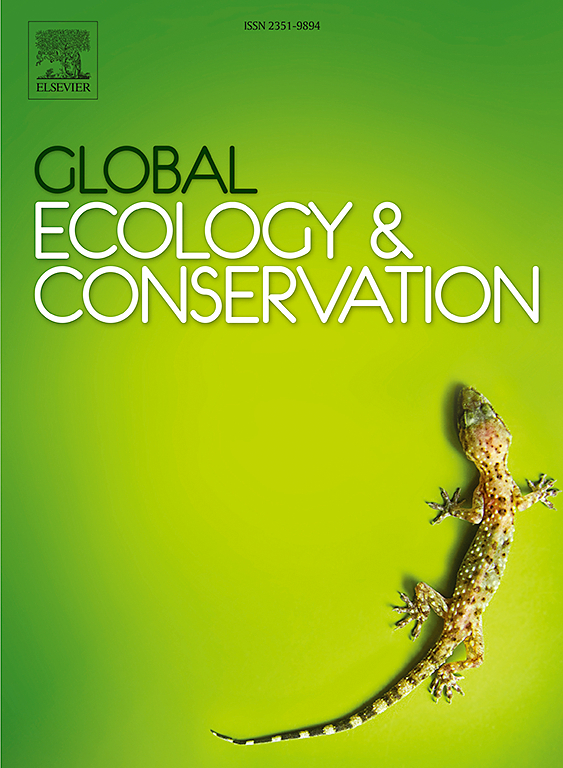大裂谷半干旱草原入侵和扩张植物物种的丰富度及其对原生植被的影响
IF 3.5
2区 环境科学与生态学
Q1 BIODIVERSITY CONSERVATION
引用次数: 0
摘要
埃塞俄比亚的植物入侵研究主要局限于少数目标物种。本研究探讨了埃塞俄比亚东部阿瓦什河谷中部入侵和扩张植物(本地但正在扩散的物种)的丰富度及其对牧场植被的影响。系统取样48个20 × 20 m样地,记录植物丰富度、丰度和草本成分。共记录到22种,分布在整个牧场,其中包括全球最多产的3种,即Lantana camara、Parthenium hysterophorus和Prosopis juliflora。扩展种对总物种丰富度的贡献(17.21 %)高于入侵种(9.90 %)。总体而言,在≥ 21 %的地块中,22个地块中只有8个(5个侵入性和3个扩张性)。进一步分析了这些物种对本地丰富度和多样性的个体和集体影响。Spearman的相关性确定了入侵/扩张植物与物种丰富度和多样性之间的关系。2 / 5的入侵种与草本丰富度呈负相关,2 / 5的入侵种与1 / 3的扩张种与树木丰富度呈负相关。入侵与扩张共生植物与草本丰富度呈负相关。只有一种扩展种和一种入侵种与草本物种多样性呈负相关,而两种入侵种和一种扩展种与本土树种多样性呈负相关。共生入侵物种与本地树木多样性呈负相关。综上所述,这些结果表明了与扩张和入侵物种相关的牧场植被可能产生的生态后果,为评估研究和管理行为的后续优先事项提供了信息决策的可能性。重要的是,考虑到它们对总丰富度的更高贡献,扩展植物对本地植被的影响可能深刻地强调了将焦点转移到这些物种上的必要性,而不是仅仅关注入侵植物。本文章由计算机程序翻译,如有差异,请以英文原文为准。
Richness and abundance of invasive and expansive plant species and their associated effects on native vegetation in a semi-arid rangeland of the Rift Valley
Plant invasion studies in Ethiopia are primarily restricted to a few target species only. This study explored the richness and abundance of invasive and expanding plants (native but spreading species) and their effects on rangeland vegetation in the Middle Awash Valley, eastern Ethiopia. We systematically sampled forty-eight 20 × 20 m plots and recorded plant richness, abundance and herbaceous composition. A total of 22, including three of the most prolific species globally, Lantana camara, Parthenium hysterophorus and Prosopis juliflora, were recorded, distributing throughout the rangeland. The contribution of expansive species to total species richness was particularly high (17.21 %) compared with the invasive species (9.90 %). Overall, only eight (five invasive and three expansive) out of 22 were encountered in ≥ 21 % of plots. These species were analysed further for their individual as well as collective effects on native richness and diversity. Spearman’s correlation identified relationships between invasive/expansive plants and species richness and diversity. Two out of five invasive species were negatively correlated with herbaceous richness, while two out of five invasive and one out of three expansive species were negatively correlated with tree richness. Co-occurring invasive and expansive plants had negative relationships with herbaceous richness. Only one expansive and one invasive species had negative relationships with herbaceous species diversity, while negative relationships of native tree diversity occurred with two invasive species and one expansive species. Co-occurring invasive species had negative association with native tree diversity. Taken together, these results suggest possible ecological consequences to the rangeland vegetation related to expansive and invasive species, offering a possibility for informing decisions to assess subsequent priorities for both research and management acts. Importantly, given their higher contribution to total richness, the effects of expanding plants on native vegetation are potentially profound highlighting the need for shifts in focus, instead of solely on invasive plants, toward these species.
求助全文
通过发布文献求助,成功后即可免费获取论文全文。
去求助
来源期刊

Global Ecology and Conservation
Agricultural and Biological Sciences-Ecology, Evolution, Behavior and Systematics
CiteScore
8.10
自引率
5.00%
发文量
346
审稿时长
83 days
期刊介绍:
Global Ecology and Conservation is a peer-reviewed, open-access journal covering all sub-disciplines of ecological and conservation science: from theory to practice, from molecules to ecosystems, from regional to global. The fields covered include: organismal, population, community, and ecosystem ecology; physiological, evolutionary, and behavioral ecology; and conservation science.
 求助内容:
求助内容: 应助结果提醒方式:
应助结果提醒方式:


